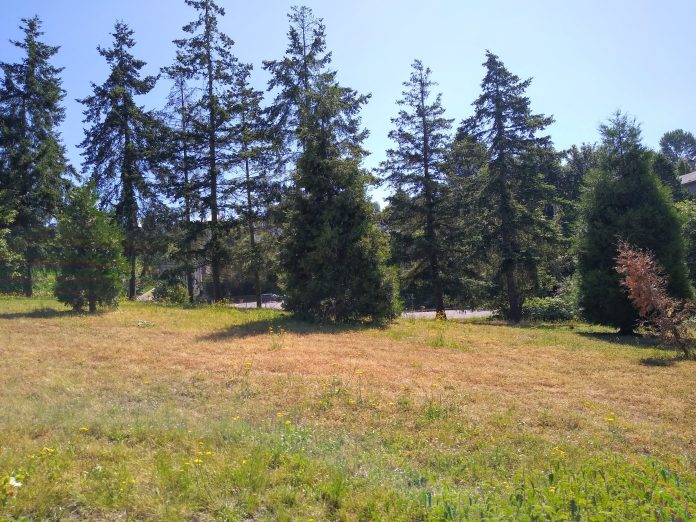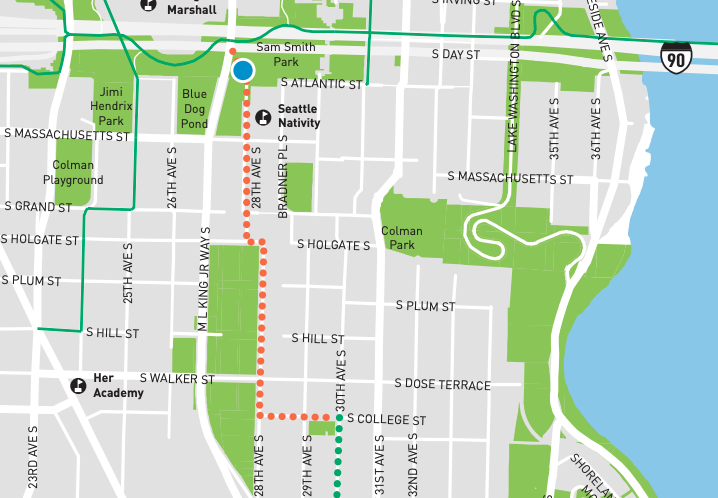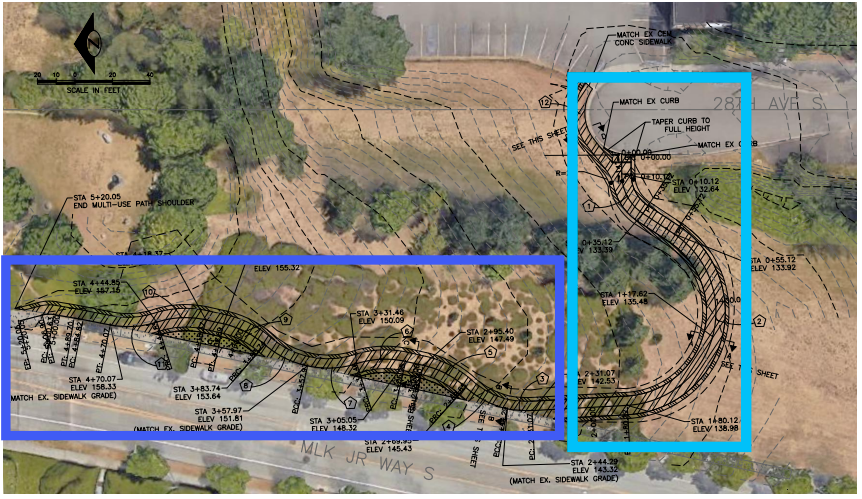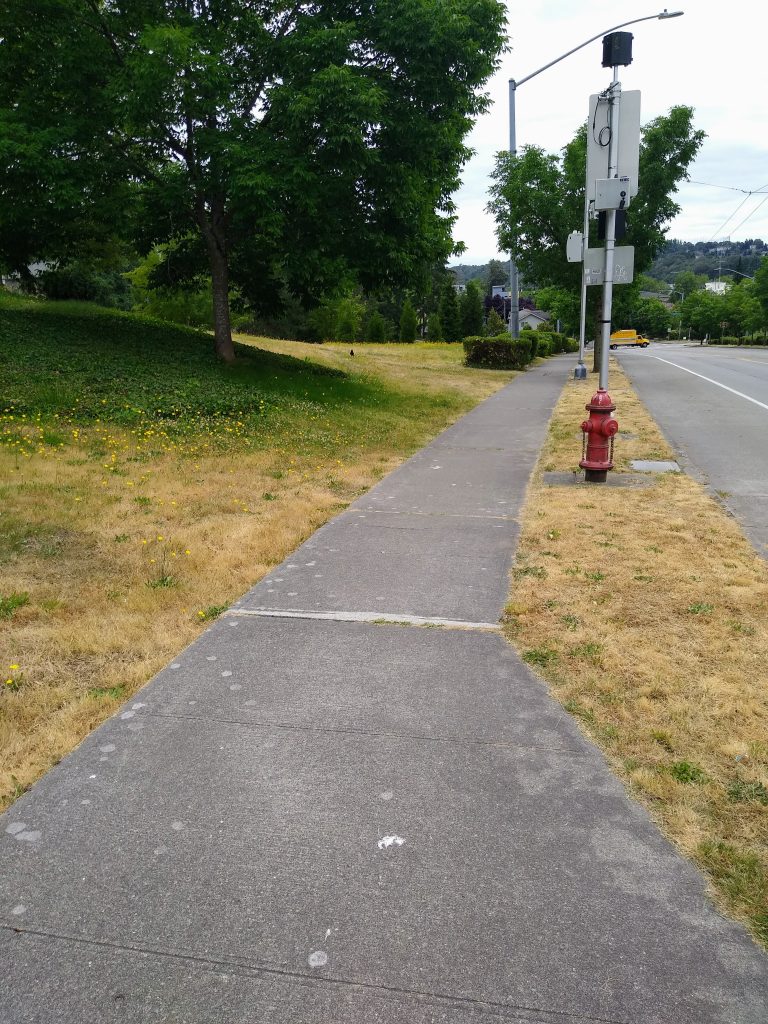
Since the five mile Rainier Valley Neighborhood Greenway officially opened in 2018, its northern end has remained unfinished, disconnected from the regional I-90 trail just a few blocks away. The Seattle Department of Transportation (SDOT) had initially planned for that final segment of greenway to connect across the public park, via 28th Avenue S, but for years plans to build that connection have failed to move forward. Newly obtained information shows that while a solution has been proposed, a technicality in state law related to “highway use” of the land on the I-90 freeway lid is blocking plans to create a safe connection for people walking and biking through the corridor.
Last summer, The Urbanist detailed the behind-the-scenes negotiations taking place that would allow SDOT to secure permission to build a trail there from the Washington State Department of Transportation (WSDOT), which controls the I-90 freeway lid. Our reporting showed how those negotiations had been going on for several years, with the only way forward offered by WSDOT an airspace lease that would add a yearly cost of $24,000, escalating with inflation, in perpetuity, which SDOT was not prepared to agree to.

One year later, new records show that SDOT had completely redesigned the walking and biking connection by late 2021 in the hopes of obtaining a no-cost trail lease, apparently due to feedback from WSDOT. As we reported last year, following a site visit in 2019, WSDOT active transportation division director Barb Chamberlain wrote to the SDOT team describing a possible path forward.
“On our walk-through we identified a possible alternative for you to consider: A short connection to the sidewalk from the end of 28th would likely be something we could say yes to… If you were to approach this as a widening of the sidewalk that wouldn’t be a new trail,” she wrote.
Previously WSDOT had said that a no-cost lease couldn’t be offered because the new connection wasn’t providing a “highway use” under state law. “The rule of thumb that is used for this is does the highway benefit from the segregation of the motoring public and the pedestrians, equestrians, and bicyclists using the trail,” was how Dorothy Miller, a WSDOT real estate specialist explained it earlier this year.
We now have plans showing exactly that, an expanded sidewalk along MLK Jr Way S and a short segment of multi-use trail connecting to the end of 28th Avenue S. “SDOT intended to have a more direct connection through the park, but WSDOT had concerns about grading and requested users be routed the I-90 Trail via MLK Jr Way S as is reflected in the current plan,” SDOT planned Kadie Bell Sata wrote to Miller explaining the proposed design.

The redesigned trail, however, didn’t actually appear to change WSDOT’s assessment of their ability to issue a no-cost lease at all. After including the project in a package of improvements set to be completed around the soon-to-open Judkins Park light rail station, the issue was again flagged and WSDOT real estate services looped back in.
“I was working with SDOT on the airspace lease at MLK. They hadn’t responded to my emails for a while, so I closed the request. I thought this was off the table,” Miller wrote to Sata. “When the AAG [Assistant Attorney General], Barb Chamberlain and I met at the sight [sic], the AAG said that the area at MLK was too far away from the highway to be a benefit to the highway or be a highway purpose; therefor[e] it would be a nonhighway use.”
A few months later, in June, Miller reconfirmed the assessment. “I have talked to a few people and they all agree that what has been provided isn’t any more than what was provided at the initial consultation when the AAG said this wasn’t a highway benefit,” she wrote.

SDOT, on the other hand, has been pushing WSDOT to consider a broader definition of highway use in approving this new connection. “It is disappointing that a technicality and narrow interpretation that gives all benefits of this valuable public land exclusively to motor vehicles to the detriment of all other travel modes and prevent good projects like this from advancing,” Sata wrote back to Miller. “This critical connection perfectly aligns with the stated mission, values, and goals of WSDOT.”
“A considerable benefit to the highway seems apparent when examining the potential for modeshift when users are provided an accessible, safe, and seamless connection to a regional mass transit station in lieu of driving a SOV on the highway (the benefit is decreased congestion, GHG emissions, maintenance, etc),” Sata wrote to Miller in another email. “Furthermore, this connection directs non-motorized users away from Rainier where there are conflicts [sic] zones with I-90 on/off ramps (including vehicle delay and crashes).”
From all appearances, these arguments have not really made any headway in arriving at a solution, despite nearly half a decade of conversations between the two agencies. The entire debacle has become a glaring illustration of how ill-prepared state law is to handle the necessary work to orient the state’s transportation network away from single-occupancy vehicles.
Even if SDOT had received a definitive “no” from WSDOT, another solution may have been implemented by now, but this issue drags on because it’s clearly not a high priority for the state agency. A city implementing their bicycle master plan as quickly as possible should be something the state does everything in its power to enable, but that’s just not the case right now, regardless of what the state law says about trail leases.
The Urbanist reached out to WSDOT to check in on how they see this project progressing. “WSDOT understands and is committed to the development of multimodal connections across our communities, but we also must follow the letter of the law,” WSDOT spokesperson Krista Carlson said in a written statement last week. “Our staff is interested in looking at this proposal with a fresh set of eyes, to better understand this project and to determine if there is a way for our agencies to move forward. We are in the process of scheduling time to discuss this issue with SDOT.”
Later this year, SDOT expects to start construction on a protected bike lane on MLK Jr Way S adjacent to this possible sidewalk trail extension, a project that wasn’t really even on the department’s radar when the Rainier Valley Greenway route was being finalized more than five years ago. Even if they overlap for a bit, the two projects clearly serve different needs and are both necessary for ensuring the safety and comfort of people walking and biking. The fact that the entire MLK Jr Way protected bike lane will be planned and implemented by SDOT during the time the competing jurisdictions were locked in debate over a small segment of trail speaks volumes about the difficulty of getting cross-agency work done.
Ryan Packer has been writing for The Urbanist since 2015, and currently reports full-time as Contributing Editor. Their beats are transportation, land use, public space, traffic safety, and obscure community meetings. Packer has also reported for other regional outlets including BikePortland, Seattle Met, and PubliCola. They live in the Capitol Hill neighborhood of Seattle.

